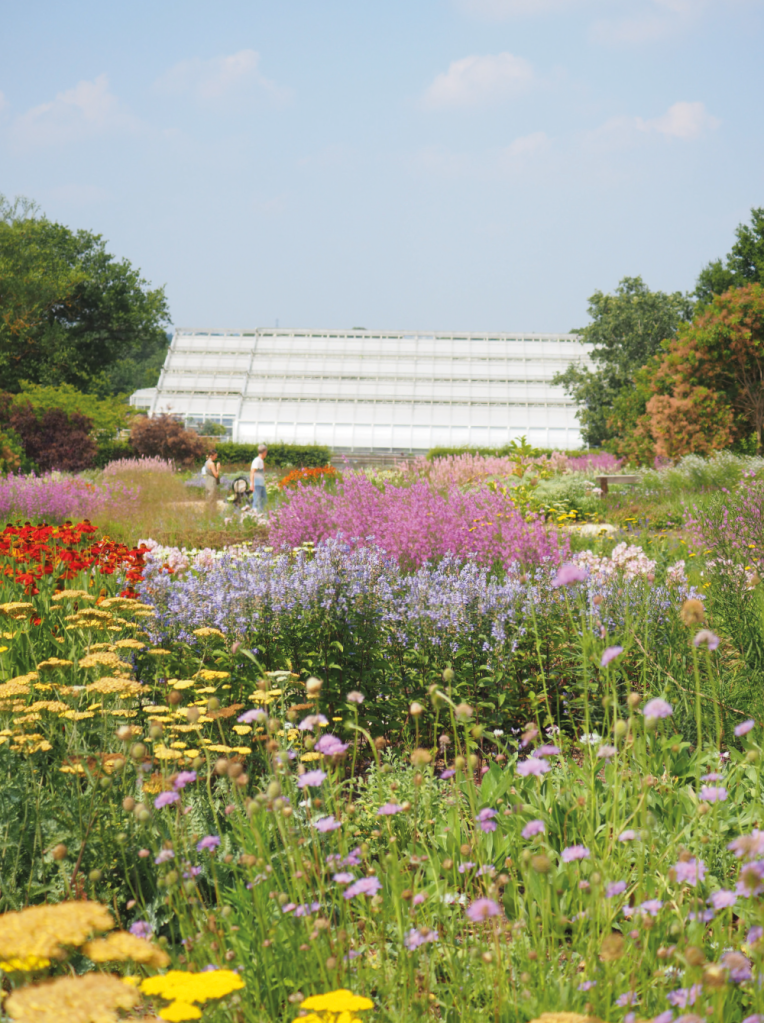Piet Oudolf’s long borders at Wisley were worn out. The famous designer had in fact become a bit embarrassed by them: they’d done well for 20 years but in that time his own style had evolved – and so had people’s tastes.
Oudolf is now such a household name that his pointillist landscaping is considered fine art on paper, let alone when actually planted up. (There are weighty coffee-table books exploring his art.) But the long borders had become, well, just borders, on either side of a long grassy walk up the hill from the Wisley glasshouses. Many of the people who visit Wisley for a walk – rather than to peer at plants – were perfectly capable of ignoring the whole lot.
Oudolf is the designer who persuaded the RHS that brown is a colour
So this year, the Royal Horticultural Society ripped it all up and got Oudolf to design them a new two-acre space. Instead of hoping people would notice his dreamy, prairie-style planting as they sauntered past, with its airy, ephemeral perennials, he forced everyone to really look at them. His new design was much more characteristic of the style for which the 80-year-old Dutch artist has become so well-loved.
It is an immersive landscape. A sinuous main path runs through looping beds set out with plants in Oudolf’s two formations: block and matrix. The first creates a generous drift that leads the eye through the planting by repeating the same herb or colour. It also contains a ‘scatter’ of another plant, often contrasting in colour and form. Some of the colour-combinations are well balanced: rich, red Heleniums with sudden spikes of Salvia ‘Blue Spire’ (formerly known as Perovskia). Others are less predictable, such as the light-pink Sidalcea, ‘Little Princess’, and the orange Asclepias tuberosa, or the tall, yellow helicopter-landing-pad flowerheads of the Achillea mixed with mid-pink wand loosestrife, the Lythrum virgatum ‘Happyness’.
The Lythrum recurs through the landscape in blocks, along with a number of other species from the same genus. At the base of some of the blocks is a scattering of low-growing Geranium sanguineum var. striatum, which you’d barely notice unless you stopped for a moment. Lysimachia ephemerum – one of Oudolf’s favourite forms – mingle with ball-like Echinops.
One of the downsides of the block form of planting is that if a species fails for some reason, it leaves gaps – like missing teeth – in a bed. This isn’t limited to Oudolf or the new perennial movement of which he was one of the founders: traditional herbaceous borders, with their groups of three or five plants, can have the same problem. There’s often a discrepancy in more established Oudolf gardens between the beautiful plan on paper and what’s now on site. But that’s gardening for you: plants fail, sometimes even in their ideal conditions.
Even Oudolf, who was a nurseryman before he became a designer, can’t have a 100 per cent success rate. But unlike some designers, he does have a deep appreciation of individual plants, understanding the conditions they need, and avoids forcing together species that have nothing in common – such as the very popular but also very weird trend of combining the moisture-loving woodland-edge plant Hydrangea ‘Annabelle’ and Mediterranean drought-tolerant lavender. There’s none of that nonsense here – but there are still some bald gaps. Other naturalistic designers bring together more diverse mixtures of plants so that if one fails, the rest of the community soon compensates and fills the space.
Criticising Oudolf for not using shrubs is a bit like whingeing that Van Gogh wasn’t into watercolour
The new landscape makes you stop and stare. There are benches placed throughout, and nearly all of them were full of people appreciating the planting when I visit on a very hot August afternoon. It is just four months since ten RHS gardeners and hundreds of volunteers set out thousands of small pots – mostly reasonably immature plants in 9cm or 2l pots – across the site. And yet it looks remarkably mature and established from a distance, with many of the plants reaching 5ft and filling their space.
Some of the drifts are more obviously new: the matrices of a number of different Molinia caerulea – a real signature plant of Oudolf’s – that appear throughout the landscape look very neat indeed. And Baptisia australis is a gorgeous prairie plant, but it spends at least the first season of growth appearing to loaf about and doing very little at all in the way of flowering. It is, in fact, like one of those colleagues who just cracks on with the job without talking constantly about their greatness: beneath the surface it is building a huge root network. But you’ll have to wait until next year to see much from it. It has an astonishing afterlife long after the flowers have faded; when the first frosts come, it turns a shocking steel grey, as though it has been blasted in a furnace.
Oudolf is the designer who persuaded the RHS that brown is a colour and as such he doesn’t rely on shrubs for structure across the season; he chooses plants that have as good a senescence as they do a prime. The ephemeral plantings that breeze and billow in the summer are frosty skeletons come the winter: Eryngium and Echinops seedheadspicked out in filigree detail and golden rustling grasses.
In fact, there are barely any new shrubs in this landscape. Nothing here is evergreen, save a few semi-evergreen grasses such as Deschampsia cespitosa ‘Goldtau’. A few young magnolias stud some of the beds. Mostly, though, the design relies on the mature Cotinus coggygria that were planted when the long borders were first done. They are a very Oudolf plant, too: deciduous and still ephemeral in appearance despite their size. Their plume flowers earn them the common name ‘Smoke Bush’. But that’s it. When the winter comes, the garden is brown, and that’s how it’s supposed to be.

The only problem I have with this is that shrubs are great and have become rather forgotten in gardening – especially among the amateur gardeners who try to mimic Oudolf (four of the blocks of planting at Wisley are designed specifically to inspire amateur gardeners). Of all the naturalistic designers in the UK, Nigel Dunnett is the solitary one to use shrubs on a large scale. That said, it was only this year that Shrouded in Light: Naturalistic Planting Inspired by Wild Shrublands came out. It was, honestly, a bit of a disappointment, as its authors were allowed to get away with some dreadfully pretentious writing when they could have been arguing the case for shrublands and their place in modern planting design.
What they could have pointed out with more force – and what the New Perennial Movement ignores – is that much of our wild landscape isn’t prairie. And we certainly don’t have any prairie in the UK. Scrubland – shrubs – on the other hand, is one of the most common, diverse and interesting wild-plant communities.
Perhaps the next Oudolf will be someone who really wows the public with some modern shrubbery. Anyway, criticising this designer for not using many shrubs is a bit like whingeing that Van Gogh wasn’t that into watercolour: they just aren’t part of his palette. It’s called the New Perennial Movement for a reason. And Oudolf has done more than probably any other modern garden designer to elevate planting to an art form that is taken seriously. He has made people fall in love with ornamental grasses, taught them to realise that there is beauty at every stage of a plant’s life cycle rather than just during its flowering prime, and helped us to appreciate a wilder, looser feel to gardening, stopping us from needing to turn everything into a Lego town.
He has made garden design better and more plant-focused, and has now made his old long borders at Wisley much better: spectacular, in fact.
RHS Garden Wisley, Woking, Surrey, is open from 10 a.m. to 6 p.m. Monday to Friday, and 9 a.m. to 6 p.m. on weekends.









Comments